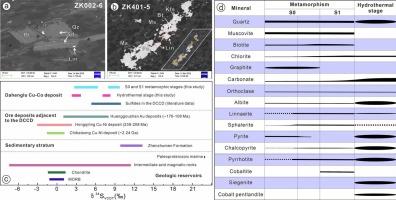Multi-stage cobalt mineralization in the Meta-sedimentary rock-hosted stratabound Dahenglu Cu–Co Deposit, northeast China
IF 3.6
2区 地球科学
Q1 GEOLOGY
引用次数: 0
Abstract
Co is an essential metal for various emerging industries. (Meta-) sediment-hosted stratabound Cu–Co deposits (SSCC) account for over 60 % of global Co production. The role of sedimentation in Co mineralization in SSCC has been reported; however, the effects of metamorphism and associated hydrothermal fluids remain unclear. Herein, we developed an orogenic-type metallogenic model for the graphitic micaschist-hosted stratabound Dahenglu Cu–Co deposit (DCCD) in the northeast Jiao–Liao–Ji orogenic belt, China. The drill holes and stratum samples revealed that the DCCD underwent diagenesis, Paleoproterozoic metamorphism, and hydrothermal overprinting. No sediment-derived sulfides were observed in the DCCD. The graphitic micaschists geochemically resemble shale, with highly negative δ13C values (−25.9 ‰ to −22.2 ‰), consistent with organic matter transformed into graphite in a semi-enclosed restricted lagoon. The Co in the Dalizi Formation (DF) originated from the weathering of 2.18–2.15 Ga Fe–Co sulfide deposits in the Lieryu Formation. Co was captured by clastic minerals and organic matter during sedimentation. The metamorphic transformation involved Co-poor pyrite decomposition and pyrrhotite, sphalerite, chalcopyrite, linnaeite, and cobaltite formation. CO2- and Cl-rich fluids mobilized metals during foliation under greenschist–amphibolite facies metamorphism. Hydrothermal overprinting formed sulfide-rich stockwork and veins. They were mainly represented by Co-rich pyrite, pyrrhotite, chalcopyrite, siegenite, and cobalt pentlandite. Analysis of the compositions and proportions of silicates, sulfides, and sulfoarsenides from 189 drill holes revealed that metamorphism-derived linnaeite and cobaltite account for over half of the Co content in the DCCD, followed by hydrothermally derived Co-rich pyrite. In summary, the sedimentary precursors of DF provided critical metallogenetic materials for Co pre-enrichment. The Paleoproterozoic metamorphism and hydrothermal fluids induced Co mineralization and re-enrichment in DCCD. These results show that DCCD is an orogenic Cu–Co deposit broadly similar to the Central African Copperbelt.

大横路铜钴矿床元沉积岩层控多阶段钴成矿作用
钴是各种新兴产业必不可少的金属。(元)沉积型层控铜钴矿床(SSCC)占全球Co产量的60%以上。沉积作用在SSCC中Co矿化中的作用已被报道;然而,变质作用和相关热液流体的影响仍不清楚。在此基础上,建立了东北胶辽造山带石墨云母岩型层控大横路铜钴矿床的造山型成矿模式。钻孔和地层样品表明,DCCD经历了成岩作用、古元古代变质作用和热液套印作用。在DCCD中未观察到沉积物衍生的硫化物。石墨云母岩地球化学特征与页岩相似,δ13C值为负(- 25.9‰~ - 22.2‰),与半封闭封闭泻湖中有机质转化为石墨相一致。大砬子组中的Co主要来源于列尔峪组2.18 ~ 2.15 Ga Fe-Co硫化物矿床的风化作用。Co在沉积过程中被碎屑矿物和有机物捕获。变质作用包括贫钴黄铁矿的分解和磁黄铁矿、闪锌矿、黄铜矿、linnaite和钴矿的形成。在绿片岩-角闪岩相变质作用下,富CO2和富cl流体在片理过程中调动了金属。热液套印形成富硫化物网状和脉状。其主要代表为富钴黄铁矿、磁黄铁矿、黄铜矿、六烯黄铁矿和钴镍黄铁矿。对189个钻孔中硅酸盐、硫化物和硫代砷化物的组成和比例分析表明,变质成因的linnaeite和cobalite占DCCD中Co含量的一半以上,其次是水热成因的富Co黄铁矿。综上所述,DF的沉积前体为Co的预富集提供了重要的成矿物质。古元古代变质作用和热液流体作用诱发了DCCD的Co矿化和再富集。这些结果表明,DCCD是一个与中非铜带大致相似的造山带铜钴矿床。
本文章由计算机程序翻译,如有差异,请以英文原文为准。
求助全文
约1分钟内获得全文
求助全文
来源期刊

Ore Geology Reviews
地学-地质学
CiteScore
6.50
自引率
27.30%
发文量
546
审稿时长
22.9 weeks
期刊介绍:
Ore Geology Reviews aims to familiarize all earth scientists with recent advances in a number of interconnected disciplines related to the study of, and search for, ore deposits. The reviews range from brief to longer contributions, but the journal preferentially publishes manuscripts that fill the niche between the commonly shorter journal articles and the comprehensive book coverages, and thus has a special appeal to many authors and readers.
 求助内容:
求助内容: 应助结果提醒方式:
应助结果提醒方式:


